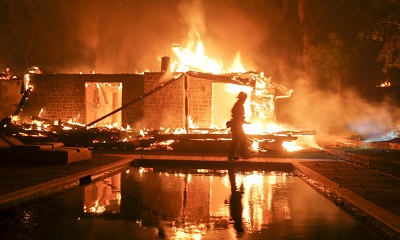Casualty insurers to be impacted by Los Angeles wildfires: Moody’s
- October 17, 2025
- Posted by: Kassandra Jimenez-Sanchez
- Category: Insurance

The insurance industry is bracing for a multi-million dollar impact, with casualty insurers facing significant liabilities from various potential triggers following the devastating wildfires that impacted Los Angeles in January 2025 – which burned over 50,000 acres and 20,000 structures and claimed 30 lives – according to a recent report by Moody’s.
While insured loss currently stands at around US$30 billion to US$40 billion, when longer-term latent damages are included, overall economic losses could reach over US$250 billion.
This figure highlights the fact that the financial fallout from this disaster extends far beyond immediate property damage
Primary insurers will initially pay out on losses attributed mostly to property damage, content loss, business interruption, and additional living expenses, though a significant proportion of homes are either uninsured or underinsured.
At the same time, more and more insurers are withdrawing coverage in high-risk areas, pushing homeowners to rely on the state-sponsored California Fair Access to Insurance (FAIR) Plan, which does not always provide the comprehensive coverage they require.
While property insurers are addressing the direct losses, Moody’s report highlights the fact that casualty insurers may also be exposed to liabilities through a multitude of potential triggers.
These range from direct allegations of ignition sources for utilities to failures in emergency response by municipal departments. Latent exposures, such as long-term health concerns, also present significant litigation risks.
A unique aspect of California law allows utility companies to be held liable for wildfires if their equipment is proven to be the ignition source, regardless of negligence. This “inverse condemnation” doctrine famously led to PG&E’s bankruptcy after the 2018 Camp wildfires.
To mitigate future bankruptcies, the report noted, the state established the California Wildfire Fund in 2019, which utilities can draw from, though they may be required to reimburse the fund if deemed imprudent by the California Public Utilities Commission.
Already, several lawsuits have already been filed against Southern California (SoCal) Edison, alleging that its transmission lines were responsible for the Eaton Fire and that the utility failed to implement timely power shut-offs despite severe weather warnings.
As a Southern California (SoCal) fund member, Edison may recover losses if it can prove “prudent mitigation.”
Another recent lawsuit alleges that a second ignition source, hours into the Palisades Fire, came from two downed powerlines owned by the Los Angeles Department of Water & Power (LADWP).
The LADWP is not a fund member, faces a lawsuit for a second ignition source in the Palisades Fire, potentially making it solely liable.
Beyond ignition sources, the report stated that casualty insurers could also face claims against professionals or businesses for alleged negligence or inadequate risk mitigation.
The LADWP for example, faces additional legal challenges concerning its alleged failure to provide timely repairs to the Santa Ynez reservoir, which reportedly left Pacific Palisades with only 2.5% of its total water storage capacity available to fight the Palisades Fire, leading to dry hydrants.
The ripple effects of the wildfires extend to numerous pre-existing issues and emerging allegations, including lawsuits against the LA firefighting department for unfair pay and understaffing, and scrutiny over delayed evacuation orders in west Altadena, where most fatalities occurred.
Furthermore, Moody’s stated: “Other liabilities can be more latent and emerge over time, such as losses incurred for the required wildfire cleanup and rebuilding, and delayed health impacts. For casualty insurers, these costs are more challenging to assess and reserve for, as responsibility is often contested and determined by legal fights around who should pay.”
These liabilities include costs associated with wildfire cleanup and rebuilding, as well as delayed health impacts from smoke inhalation, toxic waste exposure during cleanup, and ongoing air and water pollution.
This website states: The content on this site is sourced from the internet. If there is any infringement, please contact us and we will handle it promptly.



